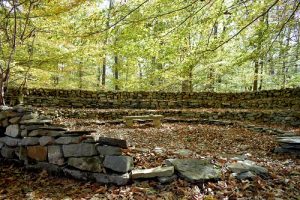
The Stone Wall

In last week’s blog I told you that I went to the Wichahpi Commemorative Stone Wall, also known as Tom’s Wall as the last stop on my solo adventure along the Natchez Trace Parkway.
The Parkway runs along part of the trail that the Indians were forced to take when the US government decided to relocate southeastern Indian tribes in the 1830s to land west of the Mississippi. There is a 50 MPH speed limit and the right of way for bicycles and wildlife is to be observed.
The Commemorative Stone Wall is known as Tom’s Wall because it was built by Tom Hendrix over a period of 30 years. Mr. Hendrix built the wall as a memorial to his great-great grandmother Te-lay-nay, a healer from the Yuchi Indian tribe which was settled near Florence, Alabama and the Tennessee River, also called The Singing River. His grandmother told him of Te-lay-nays story of relocation to Oklahoma many times when he was a child and he wanted to make sure her story was told over and over. When he was alive, Mr. Hendrix met visitors at the entrance and told them his great-great grandmother’s story as they prepared to wander along the wall. It is said that each stone was another step in Te-lay-nay’s journey.
As you enter the property there is a private drive that goes to a house that was Mr. Hendrix’s home. He passed away in 2017 at the age of 83 but his son continues the tradition of allowing guests to visit the wall.
Off to your left at the entrance, is a circular wall called Ishatae or the quiet place. This wall is built with four levels representing the circle of life: birth, life, death and rebirth.
Off to the left of the quiet circle is a straight path flanked by thick stone walls. At the end of that straight path is a stone bench that can be used to sit while resting, praying or simply listening.
This straight path represents Te-lay-nay’s exile to Oklahoma. A straight forward march to a reservation.
There is another path on the other side of the quiet place that curves and meanders and represents her five year travel alone back to The Singing River. I left all but the entrance to that path for another visit.
The entire wall, if straightened out would be 6,600 feet long. It is the longest un-mortared wall in the United States. Mr. Hendrix kept track of the equipment needed to build the wall. He stated that building the wall “wore out three trucks, 22 wheelbarrows, 3,800 pairs of gloves, three dogs and one old man”. He also wrote a book titled If The Legends Fade. For more information about the book and how to order, go to: ifthelegendsfade.net.
Visitors from around the world have come to the wall and they brought their own stones and memorial pieces. Seashells, coins, beads and other items can be found in holes and crevices in the wall.
I was very humbled by the magnitude of that wall and the time and energy that it took to build it. I fully intend to go back to that wall and explore the curved, meandering section. Until then please feel free to comment on today’s post.
The photograph shown above can be seen as a larger image here:
